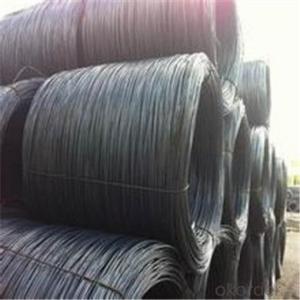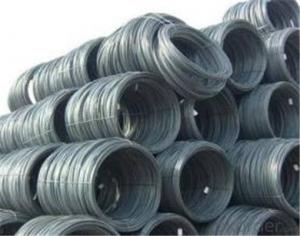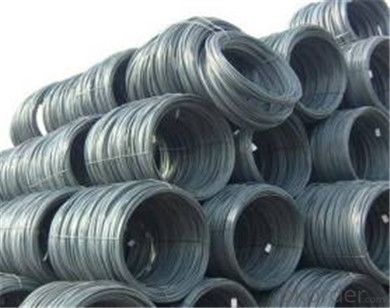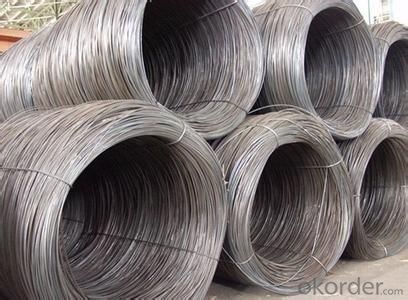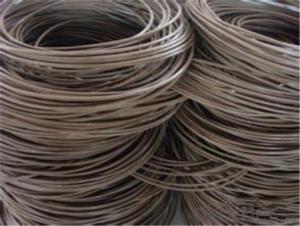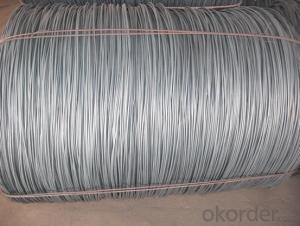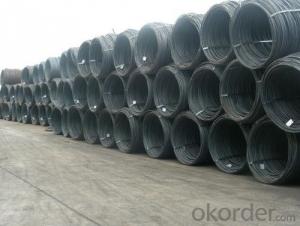Hot Rolled Steel Wire Rod 5.5mm with in China
- Loading Port:
- Shanghai
- Payment Terms:
- TT OR LC
- Min Order Qty:
- 500 m.t.
- Supply Capability:
- 45555555 m.t./month
OKorder Service Pledge
OKorder Financial Service
You Might Also Like
Specification
Description of wire Rod:
Diameter: 5.5mm,6.5mm,8mm,9mm,10mm,11mm,12mm
Grade:SAE1006/1008/1010/1012 /1015/1018
Coil weight:about 2 tons
Festures of wire Rod:
avaiable minimum order quantity: 25Tons for one size;
special size minumu quantity order: like 7mm, 9mm,11mm,3000Tons for one size;
application: concrete construction field;
torerance of thickness:±5%
Specifications of wire Rod:
Product | steel wire rod |
Standard | AISI, ASTM, BS, DIN, GB, JIS |
Material/steel grade | Q195-Q235,SAE1006, SAE1008, SAE1010, SAE1018, SAE1020 or according to customers requirements |
Wire Gauge | 5.5-12mm |
Coil weight | 1.8-2.1mts |
MOQ | 25MT |
Delivery Time | 15-30 days after receipt of L/C or deposit by T/T |
Packing | In coil and load in container, if large quantity, by bulk vessel; Can be packed as customers' special requirements |
Payment terms | 1).100% irrevocable L/C at sight. |
Application | widely used in machinery parts |
Images of wire Rod:
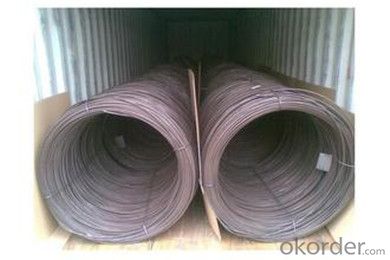
FAQ:
1. What is your package?
Packing situation: standard seaworthy packing or as customer required.
2. How long is the lead time?
Delivery time: 45 days after order confirmed.
- Q: What are the specifications for steel wire rod used in offshore wire strands?
- The specifications for steel wire rod used in offshore wire strands are typically determined by industry standards and regulations. These specifications are designed to ensure the safety and reliability of the wire strands used in offshore applications. Some of the key specifications for steel wire rod used in offshore wire strands include: 1. Material composition: The steel wire rod used in offshore wire strands should be made from high-quality carbon steel or alloy steel. The material composition should meet specific requirements in terms of strength, durability, and corrosion resistance. 2. Tensile strength: The wire rod should have a high tensile strength to withstand the heavy loads and stresses experienced in offshore environments. The required tensile strength may vary depending on the specific application and project requirements. 3. Diameter and tolerance: The wire rod should have a specific diameter and tolerance to ensure compatibility with the wire strand manufacturing process. The diameter and tolerance may vary depending on the wire strand design and application. 4. Surface finish: The wire rod should have a smooth surface finish to facilitate proper adhesion and bonding with the surrounding materials, such as resin or protective coatings. The surface finish should also be free from any defects, such as cracks or scratches, which could compromise the performance of the wire strand. 5. Corrosion resistance: Offshore environments are exposed to harsh conditions, including saltwater, moisture, and corrosive elements. Therefore, the steel wire rod used in offshore wire strands should have excellent corrosion resistance properties to prevent degradation and maintain structural integrity over time. 6. Certified testing and quality control: The wire rod should undergo rigorous testing and quality control measures to ensure compliance with industry standards and specifications. This may include testing for mechanical properties, chemical composition, surface finish, and corrosion resistance. It is important to note that the specific specifications for steel wire rod used in offshore wire strands may vary depending on the project requirements, industry standards, and local regulations. Therefore, it is essential to consult the relevant codes and standards applicable to the specific offshore application to determine the exact specifications for the wire rod.
- Q: What are the common surface treatments for steel wire rod?
- There are several common surface treatments for steel wire rods. These treatments are applied to enhance the appearance, durability, and corrosion resistance of the wire rods. One common surface treatment is galvanization. Galvanization involves coating the steel wire rod with a layer of zinc. This zinc coating acts as a barrier between the steel and the environment, protecting it from rust and corrosion. Galvanized steel wire rods are often used in outdoor applications or in environments where moisture and harsh conditions are present. Another common surface treatment is phosphating. Phosphating involves applying a phosphate coating to the steel wire rod. This coating improves the adhesion of subsequent coatings or paints, making it an ideal surface treatment for wire rods that will be further processed or painted. A third common surface treatment is powder coating. Powder coating involves applying a dry powder to the steel wire rod and then curing it under heat. This process creates a durable and attractive finish that is resistant to chipping, scratching, and fading. Powder coating is commonly used in applications where aesthetics and durability are important, such as furniture, automotive parts, and appliances. Additionally, steel wire rods can also undergo processes like pickling, where the rod is immersed in an acid solution to remove any scale or impurities on the surface, or electroplating, where a thin layer of metal is deposited onto the wire rod to enhance its appearance and corrosion resistance. Overall, the choice of surface treatment for steel wire rods depends on the specific requirements of the application. By selecting the appropriate surface treatment, the steel wire rod can be protected and enhanced to meet the desired performance and aesthetic standards.
- Q: How is steel wire rod used in the production of suspension springs?
- Steel wire rod is used in the production of suspension springs as it provides the necessary strength and durability required for these components. The wire rod is typically shaped and coiled to form the spring, which then absorbs and distributes the weight and impact of the vehicle, ensuring a smooth and stable ride.
- Q: What are the common production processes for cobalt-coated steel wire rod?
- The common production processes for cobalt-coated steel wire rod typically include wire drawing, cleaning, coating, and heat treatment.
- Q: What are the main factors affecting the fatigue resistance of steel wire rod?
- The main factors affecting the fatigue resistance of steel wire rod include the material composition and quality of the steel, the presence of any impurities or defects, the surface finish and treatment of the wire rod, the applied stress levels, the frequency and magnitude of cyclic loading, and the environmental conditions in which the wire rod is used. Additionally, the manufacturing process and heat treatment of the wire rod can also influence its fatigue resistance.
- Q: What are the different types of steel wire rod surface treatment chemicals?
- There are several types of steel wire rod surface treatment chemicals, including pickling agents, passivation chemicals, phosphating compounds, and various coatings such as zinc, copper, or chrome. These chemicals are used to remove impurities, prevent corrosion, increase adhesion, and enhance the overall quality and durability of the steel wire rod.
- Q: What are the main factors affecting the market investments of steel wire rod?
- Some of the main factors affecting the market investments of steel wire rod include supply and demand dynamics, global economic conditions, government policies and regulations, technological advancements, competition from alternative materials, and fluctuations in raw material prices. Additionally, factors such as infrastructure development, construction and manufacturing activities, and the overall health of industries that use steel wire rod also play a significant role in influencing market investments.
- Q: What are the common industry innovations for steel wire rod?
- Some common industry innovations for steel wire rod include the development of high-strength wire rods, improved surface quality and cleanliness, enhanced dimensional control, and the introduction of new alloys and coatings for specific applications. Additionally, advancements in manufacturing processes, such as continuous casting and rolling technologies, have also contributed to the innovation in the steel wire rod industry.
- Q: What are the different types of coatings used on steel wire rod?
- There are various types of coatings used on steel wire rods, each serving a specific purpose and providing unique benefits. Some common types of coatings include: 1. Zinc Coating: Zinc is one of the most widely used coatings for steel wire rods. It provides excellent corrosion resistance, acting as a protective barrier between the steel and the surrounding environment. Zinc coatings can be applied through hot-dip galvanizing or electroplating processes. 2. Polymer Coating: Polymer coatings are often applied to steel wire rods to enhance their durability and resistance to abrasion. These coatings can be made from various types of polymers, such as polyethylene or polypropylene, and are often applied through extrusion processes. 3. Phosphate Coating: Phosphate coatings are used to improve the adhesion between the steel wire rod and subsequent coatings or paints. They provide a rough surface that enhances the bonding ability of other coatings, thereby increasing their effectiveness. 4. Epoxy Coating: Epoxy coatings are commonly used for steel wire rods that will be exposed to harsh environments, such as marine or industrial applications. These coatings offer excellent chemical resistance and durability, protecting the steel from corrosion and other forms of degradation. 5. Chrome Coating: Chrome coatings provide a highly polished and decorative finish to steel wire rods. They are often used in applications where aesthetics are important, such as in the manufacturing of furniture or automotive components. 6. Nickel Coating: Nickel coatings are used to enhance the corrosion resistance of steel wire rods in highly corrosive environments, such as marine or chemical processing applications. Nickel coatings can be applied through electroplating processes. 7. Copper Coating: Copper coatings are applied to steel wire rods to improve their electrical conductivity. They are often used in applications where the wire rod will be used for electrical purposes, such as in wiring systems or electronic devices. It is important to note that the choice of coating for a steel wire rod will depend on the specific application and the desired properties of the finished product. Furthermore, some coatings can be combined or modified to achieve specific performance requirements.
- Q: How is steel wire rod used in the manufacturing of wire forms for household appliances?
- Wire forms for household appliances require steel wire rod as a vital component in their production. These wire forms serve various purposes, including heating elements, fan guards, racks, and shelves. To start the process, steel wire rod, a lengthy cylindrical piece of steel, undergoes several manufacturing stages before becoming wire forms. The initial step involves drawing, where the steel wire rod is pulled through a series of dies to reduce its diameter and increase its length. This procedure ensures that the wire attains the desired thickness and strength. After the wire is drawn, it undergoes further processing to create different wire forms. For instance, in the case of heating elements, the wire is coiled into specific shapes and sizes. This coiled wire is typically subjected to a heating process to enhance its durability and heat resistance. Regarding fan guards, the steel wire rod is bent and molded into circular or square patterns, creating a protective barrier around the fan blades. These wire forms are designed to prevent any objects or fingers from making contact with the blades while the fan is operational. Similarly, for racks and shelves, the steel wire rod is bent and welded to form a robust and durable structure. These wire forms provide support and organization for various household appliances like ovens, refrigerators, and dishwashers. Overall, steel wire rod plays a critical role in the manufacturing of wire forms for household appliances. Its strength, flexibility, and durability make it an excellent choice for creating a wide range of wire forms necessary for the proper functioning and safety of household appliances.
Send your message to us
Hot Rolled Steel Wire Rod 5.5mm with in China
- Loading Port:
- Shanghai
- Payment Terms:
- TT OR LC
- Min Order Qty:
- 500 m.t.
- Supply Capability:
- 45555555 m.t./month
OKorder Service Pledge
OKorder Financial Service
Similar products
Hot products
Hot Searches
Related keywords
